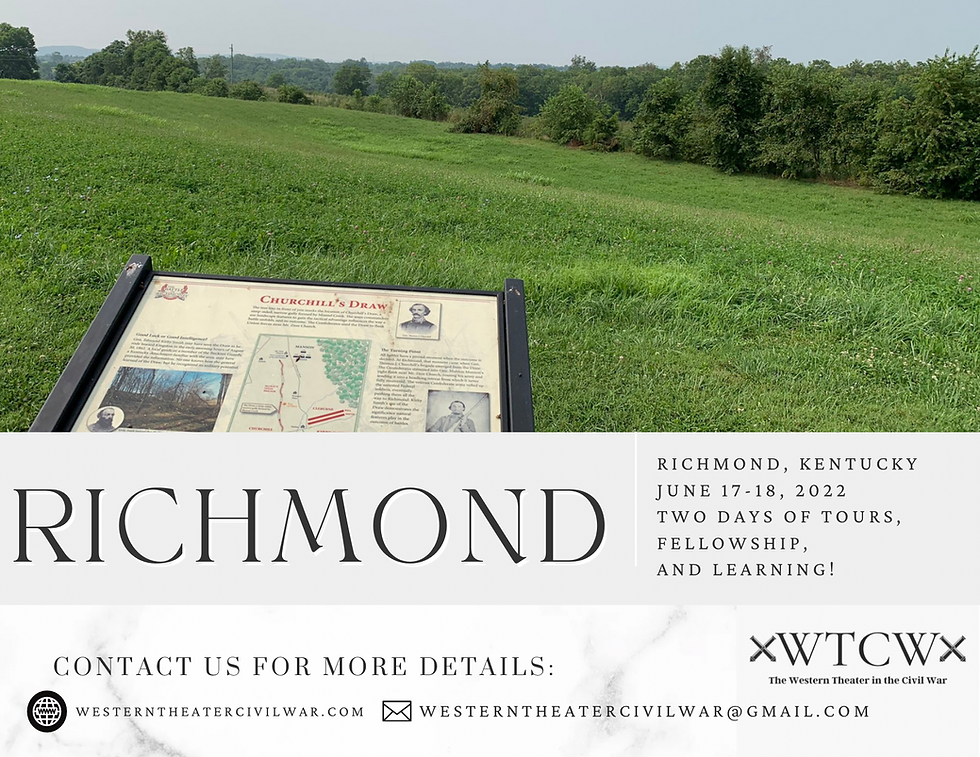The 17th Kentucky at Fort Donelson
- Derrick

- Feb 17, 2020
- 3 min read
"As my regiment was disembarking, Gen. Grant, who was at the place, said, 'I have a big contract on hand, and will have some work for you and your regiment to-day or to-morrow, and I expect to hear a good report from the Kentuckians.'"
-Colonel John H. McHenry
The 17th Kentucky is probably my favorite Union regiment to study. Mostly, it's because they are a local regiment, but I also had a cousin fight in the 17th as well. He was wounded at Chickamauga, and eventually died in a Nashville army hospital. Fortunately, he was buried near his home in Ohio County, Kentucky. Colonel McHenry practiced law in Owensboro, my home, before the war, and lived out the rest of his days here after the war. They are one of those western regiments that always fought hard. From Donelson, to Shiloh, to Chickamauga, and Atlanta. In essence, I am proud that they are from my area.
If you would like to read the diary of Sam Cox, a soldier in the 17th Kentucky, check out one of my earlier posts by clicking HERE.

Report of Col. John H. McHenry, jr.,
Seventeenth Kentucky Infantry. Fort Henry, February 18, 1862.

Colonel: On the morning of the 15th instant my regiment, numbering 510 men, preceded by the Twenty-fifth Kentucky and Thirty-first Indiana, took up our march, leaving behind our blankets, knapsacks, and a few great-coats. Hearing brisk firing on our right, we followed close upon the Thirty-first, and soon passed the right of the line of battle, when the enemy opened fire upon my right wing from behind chimps of bushes and trees, that entirely concealed them from our men. My right, with the exception of two companies on the left, were driven back from the line. I promptly rallied them on the next hill, and being joined by Captains Vaughan’s and Davison’s companies, from whom we had become separated, the regiment was moved forward and supported the Forty-fourth Indiana on our left, which had sustained a severe shock from the enemy. We soon met the enemy, and drove them back from the position they occupied against us. The firing at this point was deadly and severe. I am greatly indebted to Lieutenant-Colonel Stout and Major Calhoon for their successful efforts in encouraging the men and keeping them in their proper places in line of battle under fire of the enemy. Their efforts were particularly successful at this point, but their services were faithful and unceasing during the whole day. Lieutenant-Colonel Stout’s horse was severely wounded at this place.

About this time Colonel Logan, of Illinois, rode up and informed me that his regiment had entered between me and the enemy, and the brigade was by your order withdrawn a short distance. Some of the enemy were discovered in force on our left, where they encountered our troops and had a terrible battle, in which some 50 of my regiment, who had been separated at the first attack of the enemy, were engaged, under Adjutant Starling. This engagement was at the place where the regiment had encamped the night previous, and resulted most disastrously to our knapsacks and blankets, which had been left hanging upon the trees.

My regiment, with the Thirty-first and Forty-fourth Indiana, was withdrawn to the top of a neighboring hill, where we soon discovered the enemy in large force. We were ordered down, and I was instructed to throw my regiment out on the right, with a view of attacking the enemy, who occupied a strong position on a hill among the trees, where they could see us and were at the same time entirely concealed from our view. I ordered a charge up the hill, which, although hotly contested, was successful.
All of the officers and men behaved gallantly in this engagement. Captain Barnett led the charge on the right, and he, as well as his men, behaved nobly during the engagement. Captains Morton, Vaughan, and Davison were in the thickest of the fight, cheering their men, who behaved as gallantly as troops under the same circumstances could possibly have done. You witnessed this conflict, however, and are probably better prepared to describe it than I am myself. My regiment by your order bivouacked on this hill, where we remained during the night, and rose with the determination of renewing the attack, when we learned that the enemy had surrendered.




Captain Beckham, Lieutenants Brown, Keith, Harrison, Byers, Briggs, Davis, and Bandy deserve mention for their unceasing attention to their men during the whole day, and I feel proud 1 have received this positive evidence of their good qualities as officers. Lieutenants Taylor and Rogers, in command of a company, behaved gallantly during the day.
Respectfully submitted. JOHN H. McHENRY, Jr., Colonel Seventeenth Kentucky Volunteers.






The National colors for the 17th Kentucky you post were not issued until after the Battle of Corinth, probably the May/June 1862 battle. Battle honors for specific battles were placed on the new flags that replaced those used in the battles mentioned. These are how we can date when flags were issued.